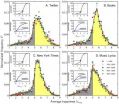(Press-News.org) Thousands more American senior citizens with kidney disease are good candidates for transplants and could get them if physicians would get past outdated medical biases and put them on transplant waiting lists, according to a new study by Johns Hopkins researchers.
The Hopkins investigators estimate that between 1999 and 2006, roughly 9,000 adults over 65 would have been "excellent" transplant candidates and approximately 40,000 more older adults would have been "good" candidates for new kidneys. None, however, were given the chance.
"Doctors routinely believe and tell older people they are not good candidates for kidney transplant, but many of them are if they are carefully selected and if factors that really predict outcomes are fully accounted for," says transplant surgeon Dorry L. Segev, M.D., Ph.D., an associate professor of surgery at the Johns Hopkins University School of Medicine and leader of the study being published in the January issue of the Journal of the American Geriatric Society. "Many older adults can enjoy excellent transplant outcomes in this day and age," he says, and should "be given consideration for this lifesaving treatment."
Those ages 65 and older make up over one-half of people with end-stage renal disease in the United States, and appropriately selected patients in this age group will live longer if they get new kidneys as opposed to remaining on dialysis, Segev says. The trouble is, he adds, that very few older adults are even put on transplant waiting lists. In 2007, only 10.4 percent of dialysis patients between the ages of 65 and 74 were on waiting lists, compared to 33.5 percent of 18- to 44-year-old dialysis patients and 21.9 percent of 45- to 64-year-old dialysis patients.
Segev cautions that some older kidney disease patients are indeed poor transplant prospects, because they have other age-related health problems. But he says his team's new findings, in addition to other recent research, show that new organs can greatly improve survival even in this age group.
Segev and his team constructed a statistical model for predicting how well older adults would be expected to do after kidney transplantation by taking into account age, smoking, diabetes and 16 other health-related variables. Using those data to define an "excellent" candidate, the information was then applied to every person 65 and older on dialysis during the seven-year study period. The researchers also determined whether these candidates were already on the waiting list.
"We have this regressive attitude toward transplantation in older adults," Segev says, "one based on historical poor outcomes in older patients, which no longer hold up. Anyone who can benefit from kidney transplantation should at least be given a chance. They should at least be put on the list."
Segev says he knows there is a shortage of kidneys and some will question whether scarce organs would be put to better use in younger patients. But Segev's study predicts that more than 10 percent of older patients would get kidneys from living relatives or friends, which would have little impact on the nationwide shortage of deceased donor kidneys. But finding a living donor first requires referral for transplantation.
"By not referring older adults for transplant, we're not just denying them a chance at a kidney from a deceased donor, but we're potentially denying them a kidney from a live donor," he adds.
According to research by Segev and his team published last year in the Journal of the American Medical Association, live kidney donation is very safe for both donor and recipient, and more older adults are donating their kidneys to relatives. Other research done by Segev has shown that older kidney transplant recipients do well with kidneys from older donors, organs that are otherwise be rejected for use in younger patients.
INFORMATION:The study was supported by grants from the National Institutes of Health and the American Federation for Aging Research.
Other Hopkins researchers involve in the research include Morgan E. Grams, M.D., M.H.S.; Lauren M. Kucirka, M.H.S.; Colleen Hanrahan, M.S.; Robert A. Montgomery, M.D., D.Phil.; and Alan B. Massie, M.H.S.
For more information:
http://www.hopkinsmedicine.org/transplant/
END
New Orleans, LA – A study led by Russell R. Russo, MD, a third-year Orthopaedic Surgery resident at LSU Health Sciences Center New Orleans School of Medicine, has identified a new source of life-threatening necrotizing fasciitis – "bath salts." The study, describing the first known case of necrotizing fasciitis from an intramuscular injection of the street drug known as "bath salts," is published in the January 2012 issue of Orthopedics, now available online.
Necrotizing fasciitis is an orthopedic emergency. The ability to quickly and accurately diagnose this rapidly ...
TORONTO, Ont., Jan. 12, 2012—Researchers at St. Michael's Hospital have published the first detailed figures showing the risk of using the prescription drug Rasilez in combination with certain other blood pressure-lowering medications.
The pharmaceutical company Novartis terminated a large, international clinical trial of the drug last month after finding an increased incidence after 18-24 months of non-fatal strokes, renal complications, high levels of potassium in the blood and low blood pressure.
As a result, Health Canada said on Dec. 22 that it would review the ...
A new study published in the journal Nature Medicine by NYU Cancer Institute researchers, shows how the cancer causing gene Notch, in combination with a mutated Polycomb Repressive Complex 2 (PRC2) protein complex, work together to cause T- cell acute lymphoblastic leukemia (T-ALL).
T-ALL is an aggressive blood cancer, predominately diagnosed in children. It occurs when one lymphoblast, an immature white blood cell, turns malignant, multiplying uncontrollably and spreading rapidly throughout the body. If left untreated, the disease can be fatal in a few weeks. Cancer-causing ...
WEST LAFAYETTE, Ind. - Honeybee populations have been in serious decline for years, and Purdue University scientists may have identified one of the factors that cause bee deaths around agricultural fields.
Analyses of bees found dead in and around hives from several apiaries over two years in Indiana showed the presence of neonicotinoid insecticides, which are commonly used to coat corn and soybean seeds before planting. The research showed that those insecticides were present at high concentrations in waste talc that is exhausted from farm machinery during planting.
The ...
"If it bleeds, it leads," goes the cynical saying with television and newspaper editors. In other words, most news is bad news and the worst news gets the big story on the front page.
So one might expect the New York Times to contain, on average, more negative and unhappy types of words — like "war," " funeral," "cancer," "murder" — than positive, happy ones — like "love," "peace" and "hero."
Or take Twitter. A popular image of what people tweet about may contain a lot of complaints about bad days, worse coffee, busted relationships and lousy sitcoms. Again, it might ...
TAMPA, Fla. (Jan. 12, 2012) – Using two cell surface markers found to be highly expressed in breast cancer lymph node metastases, researchers at Moffitt Cancer Center, working with colleagues at other institutions, have developed targeted, fluorescent molecular imaging probes that can non-invasively detect breast cancer lymph node metastases. The new procedure could spare breast cancer patients invasive and unreliable sentinel lymph node (SLN) biopsies and surgery-associated negative side effects.
Their study was published in a recent issue of Clinical Cancer Research ...
For years, researchers seeking new therapies for traumatic brain injury have been tantalized by the results of animal experiments with stem cells. In numerous studies, stem cell implantation has substantially improved brain function in experimental animals with brain trauma. But just how these improvements occur has remained a mystery.
Now, an important part of this puzzle has been pieced together by researchers at the University of Texas Medical Branch at Galveston. In experiments with both laboratory rats and an apparatus that enabled them to simulate the impact of ...
Researchers at the University of Oviedo (Spain) have come up with a way of tagging gunpowder which allows its illegal use to be detected even after it has been detonated. Based on the addition of isotopes, the technique can also be used to track and differentiate between wild fish and those from a fish farm, such as trout and salmon.
A new method for tagging and identifying objects, substances and living beings has just been presented in this month's issue of the Analytical Chemistry journal. Its creators are scientists at the University of Oviedo who have patented the ...
A new study on African bats provides a vital clue for unravelling the mysteries in Australia's battle with the deadly Hendra virus.
The study focused on an isolated colony of straw-coloured fruit bats on islands off the west coast of central Africa. By capturing the bats and collecting blood samples, scientists discovered these animals have antibodies that can neutralise deadly viruses known in Australia and Asia.
The paper is published today, 12 January, in the journal PLoS ONE, and is a collaboration of the Department of Veterinary Medicine at the University of ...
Polymer nano-films and nano-composites are used in a wide variety of applications from food packaging to sports equipment to automotive and aerospace applications. Thermal analysis is routinely used to analyze materials for these applications, but the growing trend to use nanostructured materials has made bulk techniques insufficient.
In recent years an atomic force microscope-based technique called nanoscale thermal analysis (nanoTA) has been employed to reveal the temperature-dependent properties of materials at the sub-100 nm scale. Typically, nanothermal analysis ...


